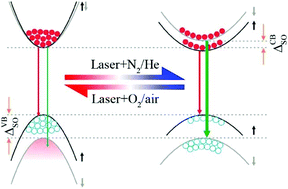Reversible engineering of spin–orbit splitting in monolayer MoS2via laser irradiation under controlled gas atmospheres†
Abstract
Monolayer transition metal dichalcogenides, manifesting strong spin–orbit coupling combined with broken inversion symmetry, lead to coupling of spin and valley degrees of freedom. These unique features make them highly interesting for potential spintronic and valleytronic applications. However, engineering spin–orbit coupling at room temperature as demanded after device fabrication is still a great challenge for their practical applications. Here we reversibly engineer the spin–orbit coupling of monolayer MoS2 by laser irradiation under controlled gas environments, where the spin–orbit splitting has been effectively regulated within 140 meV to 200 meV. Furthermore, the photoluminescence intensity of the B exciton can be reversibly manipulated over 2 orders of magnitude. We attribute the engineering of spin–orbit splitting to the reduction of binding energy combined with band renormalization, originating from the enhanced absorption coefficient of monolayer MoS2 under inert gases and subsequently the significantly boosted carrier concentrations. Reflectance contrast spectra during the engineering stages provide unambiguous proof to support our interpretation. Our approach offers a new avenue to actively control the spin–orbit splitting in transition metal dichalcogenide materials at room temperature and paves the way for designing innovative spintronic devices.



 Please wait while we load your content...
Please wait while we load your content...